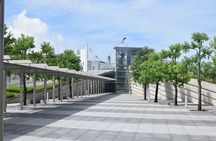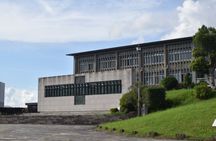
No expiration date
Easy refund
Free exchange
Easy booking
Semi-Private Guided Tour of Nagasaki (Full private min 5 people)
$124.26
This is an experience gift voucher. The recipient will book the experience after
they redeem the gift voucher.
Overview
Experience the charm, the history, the beauty of this port city. Your local Native English speaking guide will take you on a tour that will leave its mark on you. Subject to time availability and weather, the following places will be visited. Mt Inasa, the Atomic Bomb Museum, the Atomic Bomb Epicenter, Peace Park, Dejima, Chinatown, Oura Cathedral, and Glover Garden. Some of these places may be substituted on the day for other tourist sites should weather factors see us unable to visit some of them. These may include Nishizaka, Suwa Shrine, and Spectacles Bridge (Meganebashi). This tour includes entry to the sites mentioned above, public transportation (or private should tour numbers suffice), and gratuities. It does not include food or a bottle of water. Should you have challenges walking up or down stairs or slopes, please message for advice. If numbers are large enough for this to be a private tour, the itinerary is flexible. This tour requires a minimum of 4 participants in total.
—
Semi-Private Guided Tour of Nagasaki (Full private min 5 people)
Tour guide
Language: English
Human tour guide
Availability depends on seasonality and number of participants. Bookings can not be made for the same day. Please read our TnC’s.
When giving as a gift, your recipient can choose a date at their convenience during a booking process. Otherwise, you can choose one after checkout and voucher redemption.
When giving as a gift, your recipient can choose a date at their convenience during a booking process. Otherwise, you can choose one after checkout and voucher redemption.
Check available dates by emailing us at [email protected]
- In-person Guide - English, French
- Gratuities
- Public transportation
- Entrance fees for the places listed as covered.
- Bottled water
- Private transportation
- A lunch break can be arranged or a restaurant can be reserved if requested. The costs of the meals and bookings will not be covered by this tour. Please ask if you have any questions about this.
Meeting point
Known as Dejima Pier, used when Matsugae Pier is full. I will be holding a sign for easy recognition. Upon exiting the gangway, I'll be standing nearby.
I will be holding a sign for easy recognition. Please meet in front of the terminal exit.
I will be holding a sign for easy recognition. Please meet inside the station arrivals hall in front of the convenience store.
Return details
Known as Dejima Pier, used when Matsugae Pier is full. I will be holding a sign for easy recognition. Upon exiting the gangway, I'll be standing nearby.
I will be holding a sign for easy recognition. Please meet in front of the terminal exit.
I will be holding a sign for easy recognition. Please meet inside the station arrivals hall in front of the convenience store.
-
Mt. InasaMount Inasa is renowned for its stunning panoramic views of Nagasaki, especially at night when the city lights twinkle below, earning it a spot as one of Japan’s top three night views. Accessible by a scenic ropeway, the summit offers breathtaking vistas of the harbor, the surrounding mountains, and the iconic landmarks of Nagasaki. Visitors can enjoy walking trails, observation decks, and a café at the peak, perfect for taking in the beauty of the landscape. Whether you visit during the day for hiking or at night for the sparkling cityscape, Mount Inasa promises an unforgettable experience and a perfect backdrop for photography.
-
Nagasaki Atomic Bomb MuseumThe Nagasaki Atomic Bomb Museum offers a powerful and sobering look into the events of August 9, 1945, when an atomic bomb devastated the city. Through artifacts, photographs, and personal accounts, the museum details the impact of the bombing and its aftermath, highlighting the resilience of the survivors and the city’s recovery. Visitors can learn about the historical context of the bombing, the devastation it caused, and Nagasaki’s ongoing dedication to promoting peace and nuclear disarmament. A visit to this museum is a profound experience and a reminder of the importance of peace.
-
Nagasaki Peace ParkNagasaki Peace Park is a moving tribute to the victims of the atomic bombing on August 9, 1945, and a symbol of hope for global peace. The park features the towering Peace Statue, symbolizing a call for peace, along with sculptures from around the world. Nearby, the Fountain of Peace and the Nagasaki Atomic Bomb Museum share stories of resilience and remembrance. Located near the bomb’s epicenter, Nagasaki Peace Park invites visitors to reflect on history and renew their commitment to a peaceful future.
- Dejima in Nagasaki is a historic, fan-shaped island that served as Japan’s only window to the outside world during its isolation era. Originally a Dutch trading post in the 17th century, it’s now a fascinating open-air museum where visitors can walk through restored buildings, warehouses, and merchant houses. Each structure offers insight into the cultural and economic exchange between Japan and the West. Dejima’s unique architecture, period artifacts, and interactive exhibits make it a captivating journey into Nagasaki’s rich international heritage. (pass by)
-
Shinchi ChinatownNagasaki Chinatown, also known as Shinchi Chinatown, is Japan’s oldest Chinatown and a vibrant hub of Chinese culture. Founded over 300 years ago, it features colorful gates, lively streets, and unique architecture, reflecting Nagasaki’s history as a port city open to foreign trade. Visitors can enjoy delicious Chinese cuisine, from street food to traditional dishes, especially during the popular Lantern Festival. With its mix of shops, restaurants, and cultural landmarks, Nagasaki Chinatown offers a lively, immersive experience that highlights the city’s deep connections with Chinese culture and history.
-
Oura Catholic ChurchOura Church, Japan’s oldest existing Christian church, is a beautiful symbol of Nagasaki’s history and the resilience of faith. Built in 1864 by French missionaries, this Gothic-style church was dedicated to the 26 Martyrs of Japan. Known as the “Basilica of the Twenty-Six Holy Martyrs of Japan,” it holds UNESCO World Heritage status and serves as a reminder of Japan’s hidden Christian communities. Inside, visitors can admire stained glass windows and a serene atmosphere, offering a unique look into Japan’s religious heritage and its connection to the West.
-
Glover GardenGlover Garden in Nagasaki is a scenic, historic park filled with Western-style buildings from the Meiji Era, including the Glover Residence—the oldest Western wooden house in Japan, built for Scottish merchant Thomas Glover. This hillside retreat offers beautiful gardens, breathtaking views of Nagasaki Harbor, and a glimpse into the cultural exchange between Japan and the West. Each building tells a story of Nagasaki’s role as a historic gateway to the world, making Glover Garden a must-visit for anyone interested in Japanese history and architecture.
-
Nishizaka Hill*Nishizaka is a historically significant hill in Nagasaki, known for its stunning views and cultural heritage. It’s famous for the site of the martyrdom of 26 Christians in 1597, commemorated by the 26 Martyrs Monument. Visitors can explore the area’s beautiful churches, including the iconic Oura Church, Japan’s oldest wooden church, which houses a museum detailing the history of Christianity in Japan. Nishizaka also features peaceful gardens and walking paths, making it an ideal spot for reflection and appreciation of Nagasaki’s rich blend of cultural influences. The panoramic views from the hill provide a picturesque backdrop, making Nishizaka a must-visit for travelers seeking history and tranquility.
-
Suwa Shrine*Suwa Shrine, located in Nagasaki, is a serene Shinto shrine steeped in history, dedicated to the deity of war and agriculture. Established in 1624, it is known for its stunning architecture and beautiful grounds, featuring a distinctive vermilion torii gate. The shrine is famous for its annual Kunchi Festival, which showcases traditional performances and vibrant floats. Visitors can explore the lush surroundings, which include lush gardens and a peaceful atmosphere, making it a perfect spot for reflection. Suwa Shrine also offers stunning views of the city, providing a glimpse into Nagasaki’s rich cultural heritage. It’s a must-visit for anyone seeking a deeper understanding of Japanese spirituality and tradition.
-
Spectacles Bridge (Meganebashi)*Spectacles Bridge, or “Megane-bashi,” is an iconic stone bridge in Nagasaki, renowned for its unique design resembling a pair of spectacles when reflected in the river. Built in 1634, it is Japan’s oldest stone arch bridge and a symbol of the city’s rich history. The bridge features elegant arches and beautiful surroundings, making it a perfect spot for photos and leisurely walks. Located near the heart of Nagasaki, it offers picturesque views of the Nakashima River and the vibrant neighborhoods around it. Spectacles Bridge is a must-see for travelers, combining historical significance with stunning scenery.
If it’s canceled due to poor weather, you’ll be offered a different date or a full refund.
If it’s canceled because the minimum isn’t met,
you’ll be offered a different date/experience or a full refund.
How it works?
01
—
You choose from 10 000+ experience gifts
02
—
We deliver the eVoucher or the Physical box to the recipient
03
—
Recipient books the experience and creates unforgettable memories!
Semi-Private Guided Tour of Nagasaki (Full private min 5 people)
$124.26
This is an experience gift voucher. The recipient will book the experience after
they redeem the gift voucher.
How it works?
01
—
You choose from 10 000+ experience gifts
02
—
We deliver the eVoucher or the Physical box to the recipient
03
—
Recipient books the experience and creates unforgettable memories!




